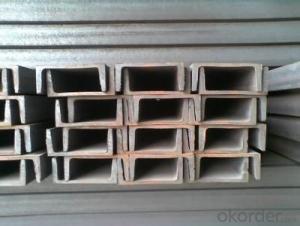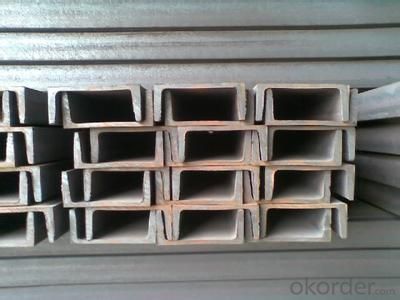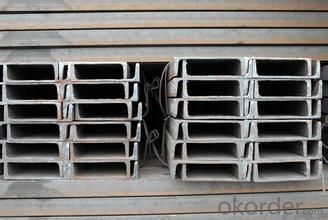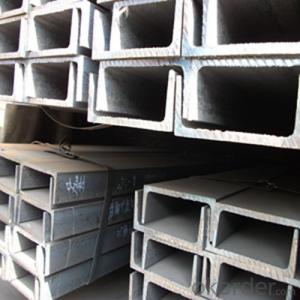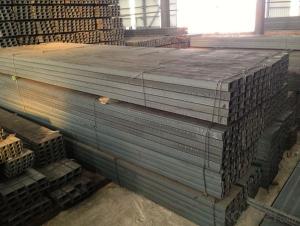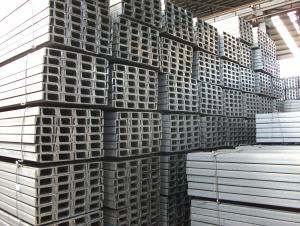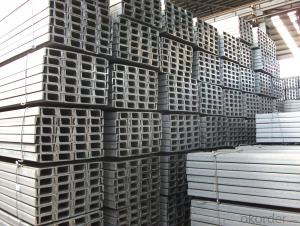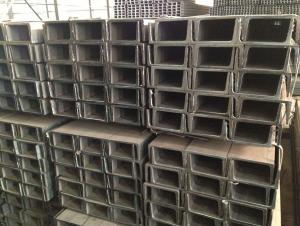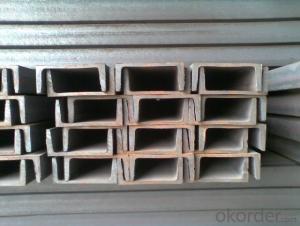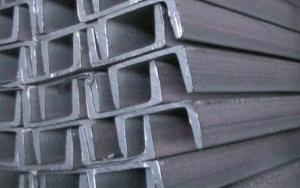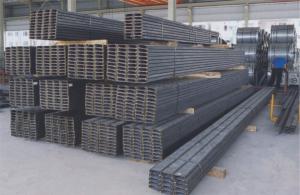Q235 Carbon Steel Channel
- Loading Port:
- China Main Port
- Payment Terms:
- TT or LC
- Min Order Qty:
- -
- Supply Capability:
- -
OKorder Service Pledge
OKorder Financial Service
You Might Also Like
Product Description:
OKorder is offering Q235 Carbon Steel Channel at great prices with worldwide shipping. Our supplier is a world-class manufacturer of steel, with our products utilized the world over. OKorder annually supplies products to European, North American and Asian markets. We provide quotations within 24 hours of receiving an inquiry and guarantee competitive prices.
Product Applications:
Q235 Carbon Steel Channel are ideal for structural applications and are widely used in the construction of buildings and bridges, and the manufacturing, petrochemical, and transportation industries.
Product Advantages:
OKorder's Q235 Carbon Steel Channel are durable, strong, and resist corrosion.
Main Product Features:
· Premium quality
· Prompt delivery & seaworthy packing (30 days after receiving deposit)
· Corrosion resistance
· Can be recycled and reused
· Mill test certification
· Professional Service
· Competitive pricing
Product Specifications:
Manufacture: Hot rolled
Grade: Q195 – 235
Certificates: ISO, SGS, BV, CIQ
Length: 6m – 12m, as per customer request
Packaging: Export packing, nude packing, bundled
Chinese Standard (H*W*T) | Weight (Kg/m) | 6m (pcs/ton) | Light I (H*W*T) | Weight (Kg/m) | 6m (pcs/ton) | Light II (H*W*T) | Weight (Kg/m) | 6M |
100*68*4.5 | 11.261 | 14.8 | 100*66*4.3 | 10.13 | 16.4 | 100*64*4 | 8.45 | 19.7 |
120*74*5.0 | 13.987 | 11.9 | 120*72*4.8 | 12.59 | 13.2 | 120*70*4.5 | 10.49 | 15.8 |
140*80*5.5 | 16.89 | 9.8 | 140*78*5.3 | 15.2 | 10.9 | 140*76*5 | 12.67 | 13.1 |
160*88*6 | 20.513 | 8.1 | 160*86*5.8 | 18.46 | 9 | 160*84*5.5 | 15.38 | 10.8 |
180*94*6.5 | 24.143 | 6.9 | 180*92*6.3 | 21.73 | 7.6 | 180*90*6 | 18.11 | 9.2 |
200*100*7 | 27.929 | 5.9 | 200*98*6.8 | 25.14 | 6.6 | 200*96*6.5 | 20.95 | 7.9 |
220*110*7.5 | 33.07 | 5 | 220*108*7.3 | 29.76 | 5.6 | 220*106*7 | 24.8 | 6.7 |
250*116*8 | 38.105 | 4.3 | 250*114*7.8 | 34.29 | 4.8 | 250*112*7.5 | 28.58 | 5.8 |
280*122*8.5 | 43.492 | 3.8 | 280*120*8.2 | 39.14 | 4.2 | 280*120*8 | 36.97 | 4.5 |
300*126*9 | 48.084 | 3.4 | 300*124*9.2 | 43.28 | 3.8 | 300*124*8.5 | 40.87 | 4 |
320*130*9.5 | 52.717 | 3.1 | 320*127*9.2 | 48.5 | 3.4 | |||
360*136*10 | 60.037 | 2.7 | 360*132*9.5 | 55.23 | 3 |
FAQ:
Q1: Why buy Materials & Equipment from OKorder.com?
A1: All products offered byOKorder.com are carefully selected from China's most reliable manufacturing enterprises. Through its ISO certifications, OKorder.com adheres to the highest standards and a commitment to supply chain safety and customer satisfaction.
Q2: How do we guarantee the quality of our products?
A2: We have established an advanced quality management system which conducts strict quality tests at every step, from raw materials to the final product. At the same time, we provide extensive follow-up service assurances as required.
Q3: How soon can we receive the product after purchase?
A3: Within three days of placing an order, we will begin production. The specific shipping date is dependent upon international and government factors, but is typically 7 to 10 workdays.
Q4: What makes stainless steel stainless?
A4: Stainless steel must contain at least 10.5 % chromium. It is this element that reacts with the oxygen in the air to form a complex chrome-oxide surface layer that is invisible but strong enough to prevent further oxygen from "staining" (rusting) the surface. Higher levels of chromium and the addition of other alloying elements such as nickel and molybdenum enhance this surface layer and improve the corrosion resistance of the stainless material.
Q5: Can stainless steel rust?
A5: Stainless does not "rust" as you think of regular steel rusting with a red oxide on the surface that flakes off. If you see red rust it is probably due to some iron particles that have contaminated the surface of the stainless steel and it is these iron particles that are rusting. Look at the source of the rusting and see if you can remove it from the surface.
Images:
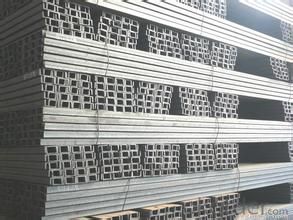
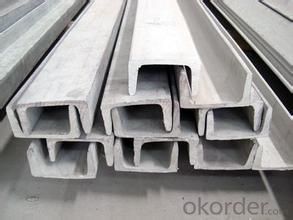
- Q: How do steel channels perform under extreme weather conditions?
- Steel channels are renowned for their exceptional performance in the face of adverse weather conditions. The inherent robustness and longevity of steel render it highly impervious to severe weather phenomena such as intense winds, torrential rains, extreme temperatures, and even earthquakes. Regarding strong winds, steel channels exhibit remarkable resilience against wind loads due to their rigidity and stability. They are engineered to endure formidable gusts without warping or bending, making them an ideal choice for areas prone to hurricanes or regions with high wind velocities. When it comes to heavy rainfall and flooding, steel channels also demonstrate exceptional reliability. They possess superior resistance to water damage and corrosion, which safeguards the structural integrity from compromise. Furthermore, steel channels can be coated or galvanized to offer an extra layer of protection against rusting and moisture infiltration. Extreme temperatures, whether scorching or frigid, do not significantly impact the performance of steel channels. Steel boasts a high melting point, rendering it impervious to heat and fire. Moreover, it retains its strength and integrity even in exceedingly low temperatures, ensuring it does not become brittle or susceptible to fractures. Lastly, steel channels have proven their resilience in earthquake-prone regions. The inherent ductility of steel allows it to flex and absorb seismic forces, thereby reducing the risk of collapse or structural damage. This is particularly critical in areas with high seismic activity, where the ability of steel channels to withstand ground shaking is of utmost importance. In conclusion, steel channels excel in extreme weather conditions due to their strength, durability, resistance to wind, water, and temperature, as well as their capacity to withstand seismic forces. Their reliability makes them the preferred choice for a wide range of applications in both residential and commercial construction, ensuring the safety and longevity of structures in challenging weather environments.
- Q: What type of channel is used for the type of room with a span of 4 meters?
- I-beam, also called steel girder, is a long strip steel with cross section. The specifications are expressed by the height of the waist (H) * leg width (b) * waist thickness (d), such as "work 160*88*6", which means that the waist height is 160 mm, the width of the leg is 88 mm, and the thickness of the waist is 6 mm. The specifications of I-beam can also be expressed by type. The model indicates the height of centimeters, such as 16#. The same height of the I-beam, if there are several different leg width and waist thickness, should be added on the right side of the model a, B, C to distinguish, such as 32a#, 32b#, 32c# and so on. The I-beam is made of ordinary I-beam and light I-beam, and the specification for hot-rolled ordinary I-beam is 10-63#. Standard Specification for hot-rolled ordinary I-beam supplied by supply and demand agreement is 12-55#. I-beam is widely used in various building structures, bridges, vehicles, supports, machinery and so on.
- Q: What are the different types of surface finishes for steel channels in architectural applications?
- Steel channels in architectural applications can be enhanced with various surface finishes, offering both aesthetic appeal and protection against corrosion and wear. The following are some commonly used surface finishes for steel channels: 1. Mill Finish: Steel channels have this basic finish when initially manufactured. It has a dull gray appearance and rough texture, often preferred in industrial applications where aesthetics are not a priority. 2. Hot-Dip Galvanized: This finish involves immersing the steel channels in molten zinc, resulting in a thick layer of zinc coating. Hot-dip galvanized steel channels have a shiny, silver appearance and exceptional corrosion resistance, making them suitable for outdoor architectural purposes. 3. Powder Coating: Powder coating is a popular option for surface finishing steel channels in architectural applications. It entails applying a dry powder followed by heating to create a durable, protective layer. Powder coating offers a smooth, even finish and comes in a wide range of colors, allowing for customization and design flexibility. 4. Stainless Steel: Steel channels can be fabricated from stainless steel, which inherently provides a corrosion-resistant finish. Stainless steel channels have a sleek, modern appearance and are commonly used in architectural designs that require a high-end, polished finish. 5. Painted Finish: Steel channels can be painted with various types of paint to achieve the desired color and finish. Painted finishes offer versatility and can be customized to match the architectural design. However, they may require periodic maintenance to prevent chipping or fading. 6. Brushed or Polished Finish: Brushed or polished finishes involve mechanically abrading the steel channels to create a smooth, reflective surface. These finishes are commonly employed in architectural applications that seek a high-quality, decorative appearance. Each type of surface finish for steel channels in architectural applications possesses distinctive characteristics and advantages. The selection of a finish depends on factors such as the desired appearance, required corrosion resistance, and the specific environmental conditions to which the steel channels will be exposed.
- Q: Are steel channels suitable for modular construction?
- Modular construction finds steel channels to be a suitable choice. These channels, also referred to as C-channels or U-channels, are commonly utilized in modular construction due to their strength, flexibility, and ease of installation. Steel channels serve as a sturdy and durable structural framework, making them well-suited for bearing the weight and load requirements of modular buildings. Their inherent strength permits the construction of large and intricate structures while maintaining stability and safety. In addition to their strength and versatility, steel channels offer the advantage of being easily fabricated and customized to meet specific design needs. This adaptability empowers architects and engineers to create modular building systems that align with desired specifications and functionality. Furthermore, steel channels possess excellent fire resistance properties, ensuring the safety of building structures. They are also resistant to corrosion, guaranteeing the durability and longevity of modular construction. Moreover, steel channels are lightweight when compared to other construction materials, making transportation and on-site assembly easier. This lightweight attribute contributes to cost savings during transportation and installation. In conclusion, steel channels are highly appropriate for modular construction due to their strength, flexibility in fabrication, fire resistance, corrosion resistance, and lightweight nature. Their incorporation in modular construction enables efficient and sustainable building processes, resulting in durable and adaptable structures.
- Q: How are steel channels used in construction?
- Steel channels are widely used in construction for various purposes. One of the primary uses of steel channels is in structural applications, where they are used to provide support and stability to a building's framework. They are often used as beams or columns to bear heavy loads and resist bending or twisting forces. Steel channels are also commonly used for framing and framing accessories, such as door and window frames. They provide a rigid and durable framework for installing doors, windows, and other fixtures. In addition, steel channels are utilized in the construction of ceilings, walls, and partitions. They can be used as support elements for attaching drywall or other finishing materials, providing strength and stability to the overall structure. Furthermore, steel channels are employed in the construction of infrastructure projects such as bridges and highways. They serve as structural components that can withstand heavy loads and provide the necessary strength and durability required for these types of constructions. Overall, steel channels are indispensable in construction due to their strength, versatility, and durability. They play a crucial role in ensuring the stability and structural integrity of buildings, making them a vital component in the construction industry.
- Q: You design expert asked: do barrier 5 meters, how long the channel to bear?
- Through my own experience, you need 10 cm or 12 cm Fang Gang (Pihou requirements GB) as the main girder, the main girder can not be separated, to ensure his strength, if conditions permit can be supported by channel 10 cm at the bottom, so it is very strong, and the spacing between the main girder beams can not exceed 400MM.
- Q: How do steel channels compare to other structural shapes?
- Steel channels are a structural shape that is versatile and widely used, offering various advantages compared to other shapes. One of the main benefits of steel channels is their high ratio of strength to weight. Their shape provides excellent support and load-bearing capacity, enabling the construction of strong and durable structures. In contrast to I-beams or angles, steel channels have a unique cross-section in the shape of a C, which provides greater resistance to bending. This makes them particularly suitable for applications where bending or torsional forces are present, ensuring the stability and integrity of the structure. Furthermore, steel channels come in a wide range of sizes and configurations, making them highly adaptable to different construction needs. They can be easily customized and cut to specific lengths, allowing for precise installation and minimizing waste. This versatility makes steel channels a popular choice in industries such as construction, manufacturing, and engineering. Another advantage of steel channels is their cost-effectiveness. Steel is a comparatively affordable material, and using steel channels efficiently in construction projects can optimize costs without compromising structural integrity. Additionally, steel channels have excellent corrosion resistance, extending their lifespan and reducing maintenance and replacement expenses. To summarize, steel channels offer numerous advantages over other structural shapes. Their high strength-to-weight ratio, resistance to bending, adaptability, and cost-effectiveness make them a reliable choice for various construction applications.
- Q: How do steel channels contribute to the overall aesthetics of a structure?
- Steel channels can contribute to the overall aesthetics of a structure by providing a sleek and modern appearance. Their clean lines and minimalistic design can enhance the visual appeal of a building, giving it a contemporary and industrial look. Additionally, steel channels can be used creatively to create unique architectural features, such as framing windows or creating transitions between different materials.
- Q: What are the load distribution factors for steel channel beams?
- The load distribution factors for steel channel beams are influenced by several factors, including the beam's size, shape, and overall structural design, as well as the type of load being applied. These factors assist in determining how the load is spread across the beam and its supporting structures. Steel channel beams generally possess favorable load distribution characteristics due to their shape and structural properties. The beam's flanges and web contribute to its stability and enhance its load distribution abilities. Various elements, such as the span length, load type and magnitude, and support conditions at both ends of the beam, play a critical role in establishing the load distribution factors. For instance, shorter span lengths usually result in a more even load distribution, while longer spans may necessitate additional supports or reinforcements to ensure proper distribution. The load distribution factors are also affected by the type of load being applied, whether it is a concentrated load or a distributed load. Concentrated loads, like those exerted by machinery or equipment, require careful consideration to ensure even distribution across the beam and prevent localized stress concentrations. Furthermore, the load distribution factors are influenced by the design of the supporting structures, such as columns or walls. Well-designed connections between the beam and its supports facilitate efficient load transfer and uniform distribution throughout the structure. To determine the specific load distribution factors for a particular steel channel beam, it is important to consult with structural engineers or refer to design codes and standards. These factors may vary depending on the application and design requirements, and adherence to industry standards is crucial to ensure safe and efficient load distribution during the beam's design and installation process.
- Q: Can steel channels be used for support beams?
- Yes, steel channels can be used for support beams. Steel channels are commonly used in construction as they have high strength and durability. They are ideal for providing structural support and can be used as beams to support heavy loads. Steel channels are versatile and can be used in various applications including bridges, buildings, and infrastructure projects. They have the ability to withstand heavy loads and provide stability, making them a suitable choice for support beams.
Send your message to us
Q235 Carbon Steel Channel
- Loading Port:
- China Main Port
- Payment Terms:
- TT or LC
- Min Order Qty:
- -
- Supply Capability:
- -
OKorder Service Pledge
OKorder Financial Service
Similar products
Hot products
Hot Searches
Related keywords
